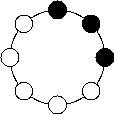I am working on stochastic processes, more specifically most (but not all) of my results concern stochastic interacting particle systems and growth models. Within this area, these are some of the more important achievements:
- Construction of processes: To establish that a stochastic model exists with the desired properties is already a nontrivial task in many cases. It had been done for many
classical
systems, but in many ways interesting models had not been constructed before. With coauthors we used sophisticated coupling arguments to build up a class of very strongly interacting processes as a limit of finite-volume (and therefore well-behaved) versions. Recently, I have also been involved in exploring blocking measures, curious equilibria that arise from artificially blocking the natural flow of particles. Surprising connections to the theory of partitions emerged.
- Microscopic description of shocks: A general phenomena in the field is that after rescaling the Law of Large Numbers takes form of a hydrodynamic limit, in which the rescaled system converges to the solutions of certain nonlinear partial differential equations. These equations possess shock solutions, the microscopic counterparts of which in the stochastic model itself are rarely understood. I was leading some investigations in which we could give detailed description of a few distributions in particular cases of models which exactly match up the definition of shocks. We also have a detailed understanding of the dynamics of these objects, and could even place the second class particle, a well known and important probabilistic object in this context. I have also contributed to our understanding of the behaviour of second class particles in the rarefaction wave, the hydrodynamic opposite of shocks.
- Current (growth) fluctuations: A breakthrough in recent years has happened as the rigorously established fluctuation picture of interacting particle systems has emerged. For some systems convergence to the famous Kardar-Parisi-Zhang equation (KPZ) is now proved, and more and more knowledge on this equation itself becomes available. From early on during these achievements we gave probabilistic proofs of the unconventional scaling that comes with this convergence in various models. Our methods are rather different from the
mainstream
arguments - in some sense more robust, and in some sense less detailed, but certainly more probabilistic in nature. We use sophisticated (second order) coupling arguments combined with combinatorial identities of the class we consider and optimisation steps to come up with time1/3 scaling results.
- Last passage percolation: Closely connected to the above themes, we have investigated last passage percolation models (LPP), particularly the one with exponential weight distribution. We extensively investigated spatial stationary properties of the model and used this to prove KPZ-scaling order. This is the analogue of the results mentioned above for particle systems - a lot of phenomena in LPP have matching behaviour in interacting particle models. We then further bootstrapped the methods to establish the correct order of fluctuations, as well as coalescence and stabilisation properties of geodesics (optimal paths in the random LPP landscape) even when the stationary structure is not present anymore.
- Blocking measures and combinatorial identities: While inhomogeneous, reversible stationary scenarios called blocking measures have been known for a long time, only recently we uncovered an incredible rich combinatorial field related to them. Reversibility adds extra structure which translation-invariant non-reversible distributions do not possess. Together with the exponential change in parameters as we move from site to site this gives rise to exotic recurrence relations and identities involving the q-Pochhammer symbols and other quantities closely related to the theory of integer partitions. Purely probabilistic and completely new proofs of several partition identities: Euler's identity, the q-binomial theorem, the Durfee rectangles identity, the Jacobi triple product identity and more emerge from these considerations.

